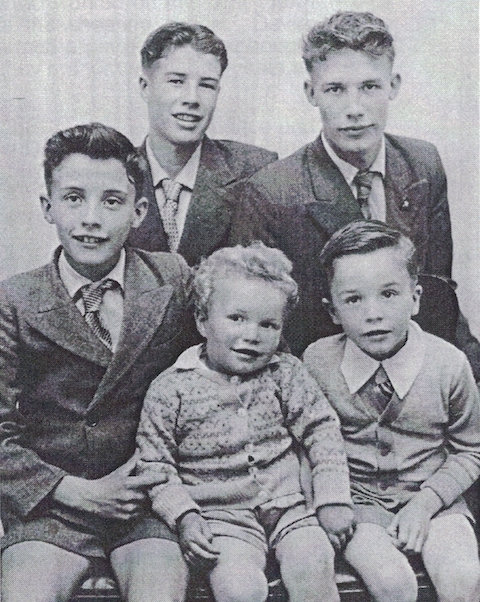

The Folk from the Wind Wound Isle > The Descendants of James Robertson
page 157
This is the most widely dispersed section of the family with individuals moving interstate from Victoria to other States at an early stage. Contact with some family members was lost and I had quite a job tracing some of them. Unless one of the unlocated children of Abbott Robertson is still alive, Margaret Haine is the only surviving great grandchild of Arthur Robertson and Margaret Henderson in this section of the family.
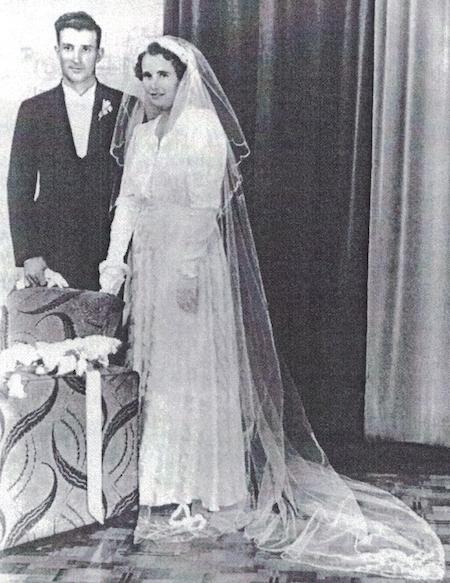
Generation D
OLlVE IVY ROBERTSON (1916-1984) - married name STRICKLAND
Eldest child and only daughter of Frederick Robertson and Edith Taylor born at Mt Magnet, WA on 18 March 1916. Known by her second name, Ivy married Harry STRICKLAND in 1940 at Geraldton. Harry worked with Ivy’s father at Mt Magnet and this is presumably how the couple met. They have five sons, Peter (1942), Bob (1944), John (1948), lan (1954) and Keith (1957).
Ivy died in 1984 and Harry in 1989, both from cancer.
Harry Strickland and lvy Robertson on their wedding day, 28 December 1940
Strickland boys, 1958. Back: Robert, Peter, front: Henry, Keith and Ian.
HENRY MACNEIL SAUNDERS (1904-1978)
Eldest child of Frances Robertson and Henry Saunders, born at Boort on 23 April 1904. Known as Neil.
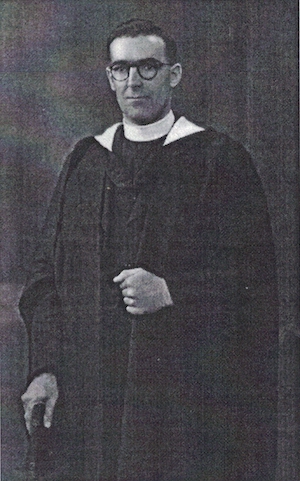 Henry McNeil Saunders
Henry McNeil Saunders
Neil’s primary education was obtained at state schools in Brisbane. He went on to Brisbane Boy’s College where he studied Greek. The family moved to Bendigo in the late 1920s and Neil attended the Teachers Training College there. He resigned before being given a teaching appointment. He felt called to the ministry and trained as a Presbyterian minister, studying Hebrew and obtaining an MA from the University of Queensland.
During the Second World War he served as an army chaplain, and while he was in Townsville he saw the Japanese observation planes flying over the town. In 1944 Neil married Nan DEMPSTER (1912-1996) in Brisbane. They have four children, Elaine (1944), Kirstin (1947), John (1949) and (Gillian (1952). The three youngest children were born at Armidale, NSW, where Neil served as minister at St Paul's Presbyterian church.
After leaving Armidale, Neil was called to the Northbridge Presbyterian Church in Sydney. He was President of the Council of Churches for one term. His last pastorate was at The Entrance on the NSW central coast. For their retirement he and Nan bought a house at Charmhaven. Neil died at the Gosford hospital in May 1978.
FRANCES RUTH ROBERTSON SAUNDERS (1906-1974)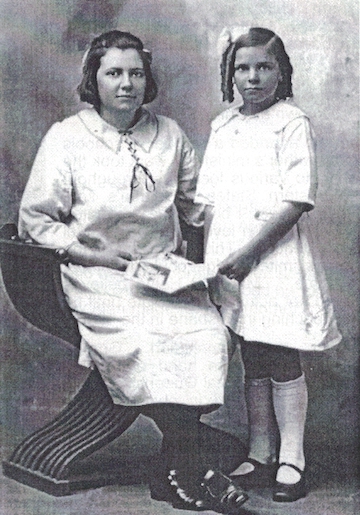
Second child and eldest daughter of Frances Robertson and Henry Saunders, born at Alexandra, Victoria on 14 December 1906. As a teenager Francis liked to be called by her given name but later her brother-in-law, David Lawson, gave her the name Fassie.
Frances Ruth Robertson Saunders with her sister Margaret
Frances trained as a teacher at the Teachers Training College in Bendigo and on completion of her training was appointed to the relieving staff of the Victorian Education Department. She taught at schools in Gippsland, the Mallee and the Western District, and at Maffra and Bendigo (Golden Square).
When the family moved to Brisbane in February 1930, Frances gave up teaching and trained as a nursing sister. She continued in this profession until she went to New Guinea as a missionary. There she worked at an American mission near Mt Hagen. Her health failed and she returned to Brisbane after eighteen months or two years and resumed nursing until her retirement.
Frances was unmarried. She died in Brisbane from leukaemia, at the age of sixty-eight.
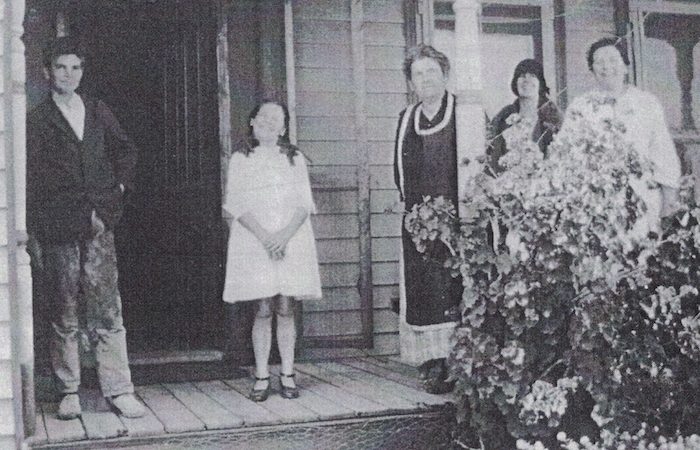
Saunders family at the Rainbow Baptist Manse, circa 1925. Left to right: Gordon, Margaret, Frances Snr, Margaret Robertson (William Adie’s daughter), Frances Jnr.
JAMES GORDON SAUNDERS (1912-1992)
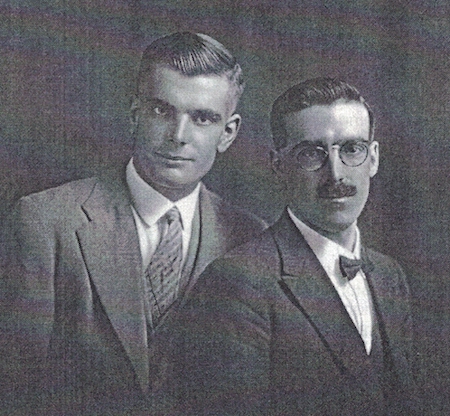 Fourth child and second son of Frances Robertson and Henry Saunders, born at Latrobe, Tasmania on 31 March 1912. He was known as Gordon. He was named after Charles George Gordon of Khartoum who was also known as Chinese Gordon. [Margaret Haine is the source of information about the names of her brothers Gordon, Alan and Douglas. Information about Gordon’s life comes from Margaret Haine and Gordon’s son Bruce Saunders.]
Fourth child and second son of Frances Robertson and Henry Saunders, born at Latrobe, Tasmania on 31 March 1912. He was known as Gordon. He was named after Charles George Gordon of Khartoum who was also known as Chinese Gordon. [Margaret Haine is the source of information about the names of her brothers Gordon, Alan and Douglas. Information about Gordon’s life comes from Margaret Haine and Gordon’s son Bruce Saunders.]
Gordon Saunders with his older brother Neil
Gordon attended a number of schools as his father’s ministerial work took the family to various locations throughout the eastern States. Gordon’s son, Bruce, writes: “l believe he graduated at matriculation level at a high school in the Bendigo. This was as far as the family’s limited budget could get him at this time.” [Email from Bruce Saunders, 24.6.1999] Margaret Haine believes he did not actually matriculate until he was teaching in Brisbane in the 1930s.
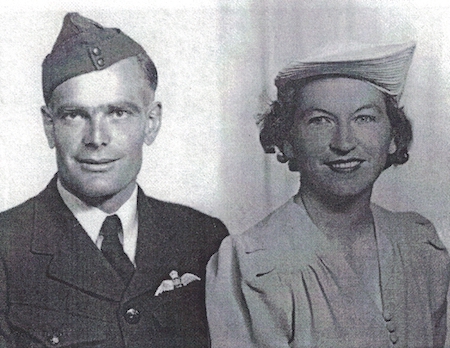 During the Depression, Gordon worked as a farm hand on station properties in Central Queensland. He was also involved in share farming with his brother, Alan, at Tamrookum in the 1930s. At some of the properties he worked as a tutor with the children living there and this is presumably what led him into a teaching career. He obtained a teaching position at the Church of England Boys Grammar School (‘Churchie’) in Brisbane.
During the Depression, Gordon worked as a farm hand on station properties in Central Queensland. He was also involved in share farming with his brother, Alan, at Tamrookum in the 1930s. At some of the properties he worked as a tutor with the children living there and this is presumably what led him into a teaching career. He obtained a teaching position at the Church of England Boys Grammar School (‘Churchie’) in Brisbane.
Gordon Saunders and Sue Gelfius, 1943
When war came Gordon joined the RAAF and served as a Pilot instructor. Gordon writes, “I do not know when he joined up exactly but l do know that he did not serve overseas due to his instructor’s role. Apparently most of the pilot training bases were scattered through central and southern NSW and northern Victoria and it was during this time that he met and married my mother.“ [Email from Bruce Saunders, 24.6.1999]
Bruce continues, “After the war he resumed working at ‘Churchie’ and was instrumental in helping to set up their Army Cadet Corps. He attained the rank of Major while serving the Corps. He was extremely proud of his role here and often used to talk about it. Some time later he rejoined the RAAF and served as an Education Officer holding the rank of Flight Lieutenant, for many years working at air bases in NSW (Rathmines on Lake Macquarie) and then in Melbourne and surrounding suburbs. He left the RAAF I think somewhere between the age 45 and 50 years (due to his age) holding the rank of Squadron Leader. He then became a student counsellor at the Royal Melbourne Institute of Technology, a post he held until he retired.”
Gordon married Sue GELFIUS (1913- ) in 1943 at Narromine in NSW. Sue came from a farming family and was the youngest of seven children. She used to raise turkeys on her family’s farm ‘Hopevale’ at Narromine. Gordon and Sue have three children, Bruce (1944), Reg (1948) and Jenny (1949).
Gordon died in the Repatriation Hospital at Heidelberg in Victoria in 1992. Sue lives in Melbourne.
ALAN THOMAS SAUNDERS (1914-1991)
Third son and fifth child of Frances Robertson and Henry Saunders, born at Sheffield, Tasmania on 28 March 1914. Like two of his brothers, Alan was named after a British Army officer, this time it was Field Marshal Edmund Henry Allenby.
His sister Margaret tells us Alan ‘was very good looking and had keen brain power, helped by a good memory’. He attended the Technical College in Bendigo where he developed his skill as a wood worker. Margaret has a delicate oval wooden pin tray Alan made for their mother.
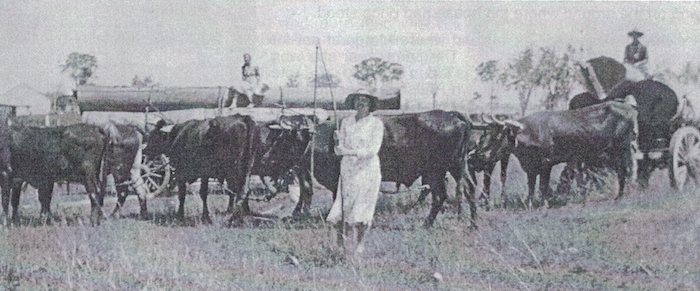
Margaret Florence Saunders with bullock team hauling timber Margaret was on holiday near Beaudesert, Qld, where her brother Alan was share farming in the 1930s
When the family moved back to Brisbane at the beginning of 1930, Alan was unable to get work because of the Depression. Much to his mother’s distress he had to leave home at the age of sixteen to look for work. Eventually he found work on cattle stations in Central Queensland and became an overseer on at least two of these properties. At one stage he was involved in share farming with his brother Gordon at Tamrookum.
During World War ll, Alan served in the RAAF as ground crew (aircraft engine fitter) with the rank of Corporal. He was posted to Bougainville in New Guinea.
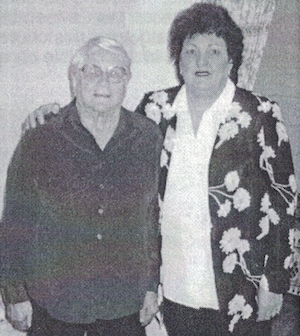
Margaret Colledge Saunders and her daughter Ruth Wroe, May 2000
On 9 November 1943 Alan married Margaret Alison COLLEDGE (1913- ) at Rockhampton. Margaret was a nursing sister. They have three children, Alan Jnr (1946), Helen and Ruth (1952). Alan and Margaret bought a house in Comet where their children were able to attend school for the first time. Previously their schooling had been by correspondence, with their mother as supervisor.
Alan experienced a number of bad accidents in connection with his work and spent periods in hospital recovering. After the children had grown up and left home, Alan and Margaret moved to Rockhampton. Alan died there in 1991 and was given a returned serviceman’s funeral. Margaret still lives at Rockhampton.
MARGARET FLORENCE ELLERSLIE SAUNDERS (1915- ) - married name HAINE
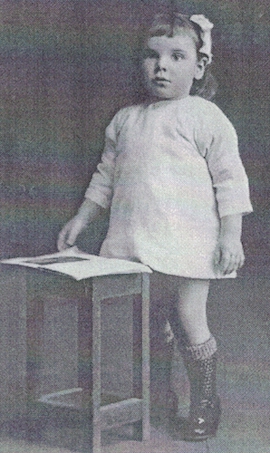 Sixth child and youngest daughter of Frances Robertson and Henry Saunders, born at the Albion Baptist manse on 21 December 1915.
Sixth child and youngest daughter of Frances Robertson and Henry Saunders, born at the Albion Baptist manse on 21 December 1915.
Margaret Saunders at about 2 years of age
ln October 1925 while in 4th grade at Rainbow, Margaret won first prize in an essay competition at the local show, for a story about Dobbin the horse. Margaret modestly says her father coached her. While living at Rainbow, Margaret visited her Mott relations. She also remembers going to school at Port Campbell when the family stayed there in 1926. She would walk to school past the site of ‘the old stone house’ and there were still piles of stones lying on the ground where the house had once stood.
Margaret Saunders at 17 years of age

The family moved to Queensland where Margaret sat for her scholarship exam in 1930. The same year she won two essay competitions. One was for an essay to celebrate the opening of the Brisbane Town Hall, the other from the Dickens Fellowship. She also won a Shell bursary for an essay describing the Shell Company works in Brisbane. With the benefit of the bursary, a State scholarship and a reduction in fees because of her father’s occupation, Margaret was able to attend Sommerville House for her secondary education. The school supplied textbooks and stationary for a cost of £1/10/- per term and the reduced fee amounted to £1/15/- per term. Margaret was dux of the school in 1934. She went on to train as a teacher of the deaf, working at the School for the Deaf in Brisbane.
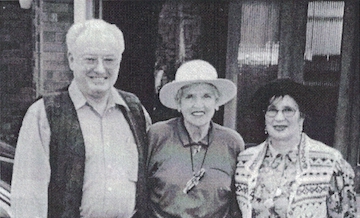 In 1949 Margaret married Hector HAINE (1911-1992) at the Baptist Tabernacle in Brisbane. They had no children. Hector was a schoolteacher, a lecturer at the Teachers College and finally head of the education section. He wrote “Classroom Psychology" and several other textbooks. Hector’s parents came to Australia from Sweden and Hector was a member of the Swedenborgian Church. Margaret joined this church. Margaret and Hector visited Shetland in 1978 while on a visit to Europe.
In 1949 Margaret married Hector HAINE (1911-1992) at the Baptist Tabernacle in Brisbane. They had no children. Hector was a schoolteacher, a lecturer at the Teachers College and finally head of the education section. He wrote “Classroom Psychology" and several other textbooks. Hector’s parents came to Australia from Sweden and Hector was a member of the Swedenborgian Church. Margaret joined this church. Margaret and Hector visited Shetland in 1978 while on a visit to Europe.
Margaret Saunders Haine, 2000, with her niece Kirstin Gillam and Kirstin’s husband John
Like so many of her relations Margaret plays the piano. One of her hobbies is making hats, which she does with great skill and fine stitch work. She also makes artificial flowers, and her other hobbies include cake icing and cane basketwork. She disliked moving about as a child and has lived in the same house in Annerley since 1951.
DOUGLAS DAVIS SAUNDERS (1918-1964)
Youngest child of Frances Robertson and Henry Saunders born at Enoggera, Queensland on 28 April 1918. Douglas was given the name of World War I British Army officer Field Marshal Douglas Haig. [Interview with Margaret Haine]
Douglas had Down syndrome and as an adult received an invalid pension. He died at the age of forty-six, a resident at ‘Walston Park’ in Brisbane. He was unmarried.
ADIE CHRISTINA ROBERTSON (1907-1999) - married name REUDAVEY
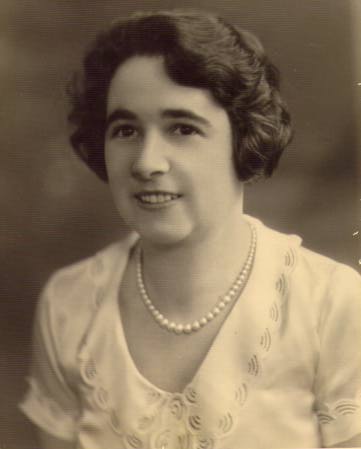 The eldest child of James Need Robertson and Christina Bennett, born at Ballarat, Victoria on 9 September 1907.
The eldest child of James Need Robertson and Christina Bennett, born at Ballarat, Victoria on 9 September 1907.
Adie Robertson Reudavey
At the age of fourteen, Adie started work as a machinist in the soft furnishing department of Ahern’s Emporium in Perth and one of her tasks involved making curtains for the Capitol Theatre. “During the Depression Adie was the only one of the household to have a job, so her pay kept the family afloat.” [From the eulogy presented at Adie’s funeral service in 1999.]
In 1934 Adie married Frances (Frank) REUDAVEY (1904-1995) at the Trinity Congregational Church in Perth. They have three children, Phillis (1935), Rod (1938) and Thia (1944). After their marriage Adie and Frank lived on a farm at Jibberding in WA. There, Adie was a foundation member of the local branch of the Country Women’s Association, an organization she belonged to for over sixty years. She was involved in Congregational and Uniting Church activities, the Dalwallinu Hospital Auxiliary, and served as President of the Senior Citizens Association. She was made a life member of the last two organizations. Adie was actively interested in handicrafts, demonstrating as well as being a judge on the show circuit, including the Royal Perth Show. Phillis remembers, “Mum made stools out of Sunshine milk tins. Covered the tins with material, sewed them together and covered all - very strong and a good height. Mum and Gran both only 5ft so that's why there were always stools at 98 [Eighth Ave] and on the farm. I have some of them!" [Adie‘s story is compiled from correspondence with Phillis Dolling. Unless otherwise stated the quotes are taken from Phillis’ letters.] Adie neither drank nor smoked and lived into her ninety-second year. Two of her sayings quoted in her eulogy were: “Don’t worry about things you can’t change” and “Being short never stopped me doing anything.”
The Reudavey family name was originally Davey. When Frank's father, Henry Richard Davey worked as a gardener at the Queen’s Gardens in Perth (before becoming a farmer), there were others with the name Davey and this caused confusion when mail arrived from England. So Henry called himself Rewell-Davey, Rewell being his mother‘s maiden name. Somehow the name was contracted to Reudavey and that's the way it has stayed.
The Reudavey family were pioneers in the Jibberding district, which is twelve miles east of Wubin in the Shire of Dalwallinu. Phillis tells us “the Jibberding district was named after the Jibberding sheep station - east of the rabbit proof fence - and Dad’s block (Limberlost) adjoined the station. Now it is cropped, but in those days was a pastoral property, and everyone took their sheep to the shearing shed to be shorn. I can remember helping Dad move the sheep from Limberlost (around the edge of the lake) to Jibberding Station."

Robertson family group, Perth circa 1948. Left to right, back row: Dave and Mollie Gillard, Gert and Norman Robertson. Centre row: Adie Reudavey, James Need and Christina Roberston, Frank Reudavey. Front row: Graeme Robertson, Thia Reudavey, Garry Gillard, Rod and Phillis Reudavey.
Frank Reudavey was the eldest of nine children. At the time of writing the original farm is still being run by Frank’s youngest brother, Jack Reudavey, and Jack’s son, Trevor. Frank and Adie’s son, Rod Reudavey and his wife Judith, now run ‘Limberlost’ and with the help of their son Peter.
Adie and Frank’s first house at Jibberding was made from wheat and super bags and they lived in this while their mud brick house was built. This second house was called "Limberlost” because Adie associated it with the mud brick house in the novel ‘The Girl of the Limberlost’. Later on Limberlost incorporated an adjourning property called ‘Golden Valley’ because of the golden wattle trees that bloomed near the weatherboard house. The family moved into the house of four bedrooms, front verandah and bathroom, in 1944 or 1945. This house was on the main road (the Great Northern Highway) and Phillis and Rod could ride their bikes to school in Jibberding. The mail run to Payne’s Find passed the gate, so mail and groceries were delivered each week. However to use a phone meant going to Nanna Reudavey’s about 4 miles away. Nanna Reudavey was the Post Mistress and ran the exchange for thirty-three years. She was awarded a British Empire Medal (BEM).
The Golden Valley house was also closer to Wubin where Thia attended school, the Jibberding School having closed by that time because of fluctuation in the number of children attending. lt was not until 1963 that Adie and Frank moved into a house that had a telephone, running water, a sink in the kitchen, hot water from the Metters No 2 stove and a septic toilet. This house was built just inside the boundary between Golden Valley and Limberlost but at the opposite end of the farm to the original house. Phillis writes, “lt was too stony for much of a garden but lots of pot plants - indoors and outside. A flower box around the front wall of the patio, that Rod still puts in petunias etc, for a splash of colour."
ln 1993 Adie developed shingles and after her stay in Dalwallinu hospital she and Frank moved into ‘Pioneer House’ in Dalwallinu. This made it very easy for family and friends to visit them and they received good care from the devoted staff. Phillis tells us, “it was a happy time for them both". Frank died in 1995, Adie in 1999.
Thia Reudavey Wright with Rod and Judith Reudavey, Perth 2000
JAMES NORMAN ROBERTSON (1909-1983)
Second child and only son of James Need Robertson and Christina Bennett born at Claremont, WA on 8 August 1909. Known as Norm.
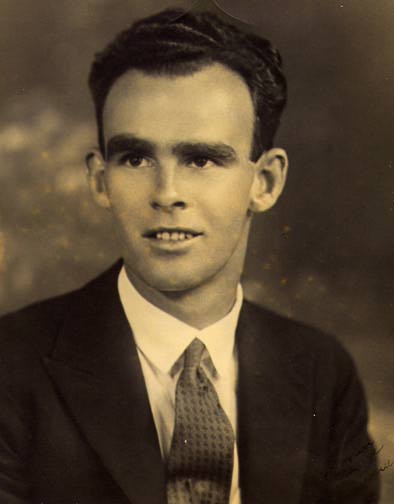
James Norman Robertson
His son, Graeme, writes about Norman, “Dad was a very heavy smoker and I recall when I was a child marvelling at the nicotine stained fingers and moustache, remembering every morning as soon as he got out of bed almost coughing himself to death. But he would settle down with the rollin’s before breakfast. He certainly paid the price.” [Letter from Graeme Robertson, 10.12.1998] Norm died a lingering death from emphysema, at the Hollywood Repatriation Hospital, Perth. Norm also drank heavily after he came back from World War II, putting a considerable strain on his family. He was charged several times for drink driving, and his driving licence was eventually taken away for life.
Norm married Gertrude MURDOCH (1913-1974). Gertrude was the youngest child of James Harding Murdoch and Gertrude Hoare of Portsmouth England. There were three children in the family, Kenneth, Constance and Gertrude Jnr. After the First World War, James Murdoc left his family in England and went to America. In 1919 Gertrude Snr brought her three children to Western Australia at the suggestion of her sister Constance. Constance and her husband Harry lived on a struggling farm near Babbicon on the edge of the WA wheat belt. Gertrude and the two older children worked on the farm as labourers, finding it a hard life. Gertrude Jnr however was less aware of the hardships, being too young to work in the paddocks. She had happy memories of horse riding into Babbicon to pick up the mail, etc.
The farm did not prosper and Uncle Harry committed suicide. The two women brought the children to Perth where they ran a boarding house. Constance returned to England to look after her brother Horace, and the third sister, Winifred, who was unmarried, came out to Australia to help Gertrude run the boarding house. Gertrude Jnr became an expert seamstress and dressmaker.
When World War II started Norm, who was just turning thirty, put his age down to ensure he would be accepted into the army. He served in the Middle East, New Guinea and Borneo. After the war Norm worked for H J Ingle in Perth, turning old army tanks and Bren gun carriers into bulldozers. These were in urgent demand for clearing virgin scrub to extend the West Australian wheat belt. Graeme tells us his father was a first rate metalworker and ‘a nice bloke when he wasn’t drinking’. [Interview with Graeme Robertson in lnnisfail, February 2001]
Both Norm and Gertrude smoked heavily and both died of smoking related diseases. “My mother died when she was only sixty three of a heart attack. She had a pain in the chest one day and told no one, and sat up all that night smoking and worrying about it." She died at the wheel of her car the next day, 2 August 1974, which was the day her husband was retiring from work. Norm lived for another nine years.
MARY LINDA ROBERTSON (1915-1988) - married name GILLARD
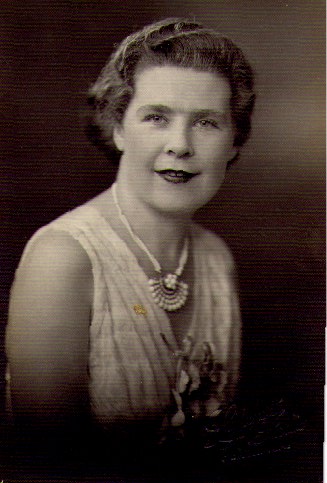 The youngest of James Need Robertson and Christina Bennett’s three children, born at Geelong, Victoria on 24 November 1915. Known as Linda as a girl and Mollie as an adult.
The youngest of James Need Robertson and Christina Bennett’s three children, born at Geelong, Victoria on 24 November 1915. Known as Linda as a girl and Mollie as an adult.
Mary Linda Robertson
Graeme Robertson describes his Aunt Mollie as ‘the lynch pin of the social fabric of that era of the family.“ [Letter from Graeme Robertson, 10.12.1998] After her marriage in 1938 to David GILLARD (1905-1982), Mollie refused to leave her mother and she and David lived with Christina in the house at Maylands. This household was a meeting place for all the family. Mollie and David’s only child Garry was born in 1943. The country cousins from Jibberding stayed with the Maylands family so they could attend school and work in Perth. Thia and Rod would marry Don Wright and Judith Coultas who went to school with Garry Gillard.
Mollie was a designer/dressmaker, working at different times for Rene Elser Modes in Ahern’s Arcade, and American Styles, Dressmakers of Distinction, McDonald Buildings at 146 Murray St, both in Perth. Later she worked for herself, her business card stating: “Mrs M. Gillard, Exclusive Dressmaker. Fittings in your home." [Quotes from G. Gillard are taken from a letter, 4.10.1999] Mollie had a little Morris Minor car, which was ‘her pride and joy’ and this was what enabled her to make home visits. Garry gives us a picture of his mother sitting at her industrial sewing machine (fast but no fancy attachments) in her ‘workroom’ which was the enclosed side verandah of his grandmother's house in Maylands. Other furniture in this long narrow room included a cutting table made from an old dining table raised on 15cm jarrah blocks; a flat ironing table, with two drawers, on which stood a sleeve board; a couch and a chair opposite Mollie for visitors.
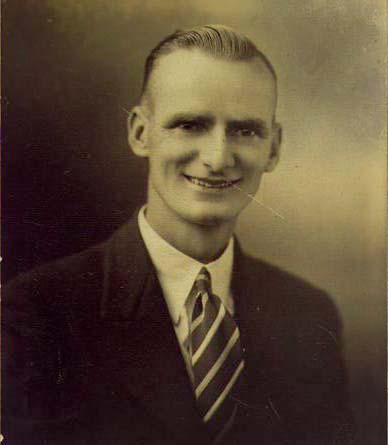 Garry still has the chair plus a second one from the house, made from woven cane by the ‘blind’. “lf a client wanted a dress like one in a magazine, Mum was able to draw the dress on paper, take her measurements, cut it and sew it.” She specialized in wedding outfits with dresses for the bride, the bridesmaids and their mothers. Phillis tells us that Grandma Christina did most of the hand sewing on dresses, gowns, coats etc. Her rouleau work and hemstitching were much sought after.
Garry still has the chair plus a second one from the house, made from woven cane by the ‘blind’. “lf a client wanted a dress like one in a magazine, Mum was able to draw the dress on paper, take her measurements, cut it and sew it.” She specialized in wedding outfits with dresses for the bride, the bridesmaids and their mothers. Phillis tells us that Grandma Christina did most of the hand sewing on dresses, gowns, coats etc. Her rouleau work and hemstitching were much sought after.
David Gillard
David Gillard had a variety of jobs over the years. Before he was married, Dave drove parlour cars between Perth and Fremantle. He was a munitions worker during the Second World War and later a lathe operator at Altona engineering works at Scarborough. While he was there he made a ring for his niece Phillis out of shilling. After leaving the engineering works Dave drove a taxi. Basically however he was a musician, playing double bass in the Symphony Orchestra and a Hawaiian ensemble on ABC radio, as well as in other groups. He also played the piano - not too proficiently according to his son. On the other hand Phillis tells us how much she enjoyed his piano playing. Dave worked as a piano tuner, and repaired old pianos for resale.
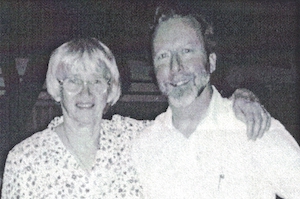 Phillis’ grandchildren are now playing on the piano Dave found and restored for her. Dave had a Holden van for carrying his tools and his double bass.
Phillis’ grandchildren are now playing on the piano Dave found and restored for her. Dave had a Holden van for carrying his tools and his double bass.
Garry Gillard with Margaret Worrall, Perth 2000
Dave gave up drinking in his forties because he was diagnosed with cirrhosis of the liver, but took it up again in his later years. Mollie and Dave were heavy smokers and both died of cancer, Dave in 1982 and Mollie six years later.
MIRIAM WlNlFRED LAWSON (1912-1998)
RUTH GWENDOLINE LAWSON (1915-1930)
GLADYS IRENE LAWSON (1919-1991) - married name MUNRO
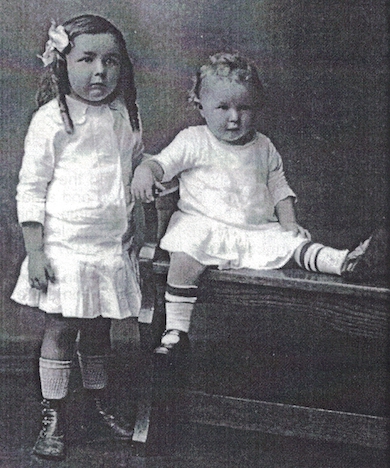
I have very little information about these three sisters who were the daughters of Miriam Robertson and David Lawson. They were all born, lived and died in Brisbane, Queensland.
Winnie and Gwen Lawson
Gwen, the middle child, was born on 16 February 1915. She died from rheumatic fever at the age of fifteen. This was the second bout of an illness she had had as a child. She is said to have been a gifted performer and had learnt elocution. Her rendition of ‘I’d never get a hidin’ with the Minister to tea’ was a family favourite.
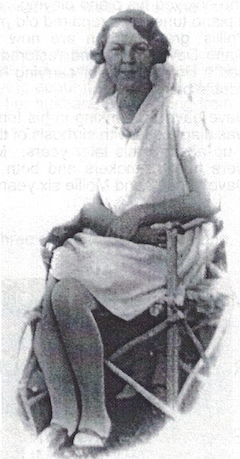
Gwen Lawson
Win and Irene were pianists. Win the eldest girl was born on 16 March 1912. She did not marry and worked for a time as a kindergarten teacher. Later she became a typist in a department store in Brisbane. She seems to have had an interest in keeping in touch with her relations and I have some Christmas cards she sent to her cousin Adie Robertson Reudavey in WA, and letters to other family members, which provided a starting point for some of the information contained in this family history. It therefore seems sad that I know so little about Win herself.
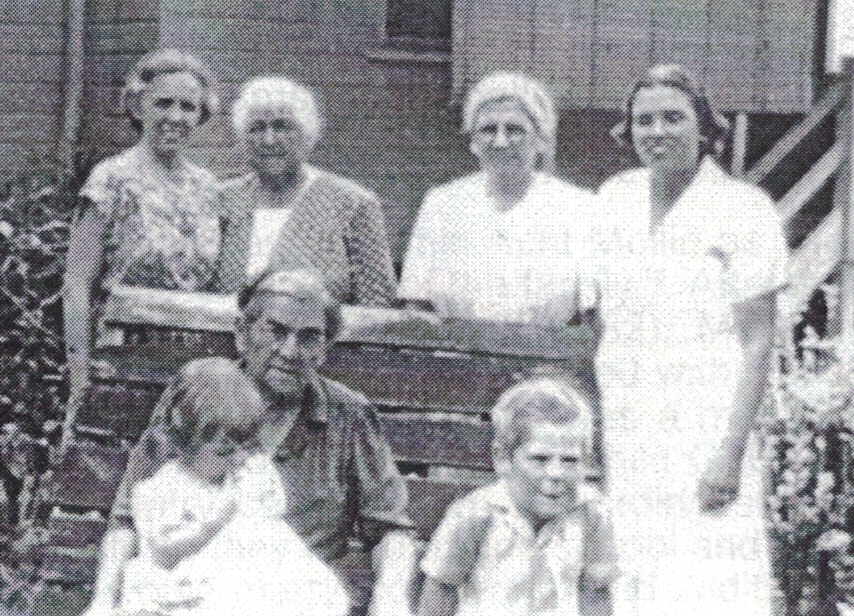
Lawson-Saunders Family Left to right, back row: Sue Saunders(?), Win Lawson, Frances Saunders Jnr, Margaret Haine. Seated: Grace Saunders Snr with Sue's children Jeanette and Reg.
Irene was born on 28 February 1919. She worked as a ladies hairdresser. ln 1947 she married John MUNRO at the Scots Presbyterian Church in Brisbane. John Munro was a garage proprietor. Their only child, born in 1950, is called David after his grandfather. David has kindly allowed me to copy some wonderful photos from his mother’s photo album. John Munro died in 1953, Irene in August 1991.
Generation E
GORDON BRUCE SAUNDERS (1944- )
Eldest son of James Gordon Saunders and Susan Gelfius, born at Temora, NSW on 10 November 1944. Known as Bruce.
Bruce left school at sixteen and joined the Victorian Country Roads Board in 1961 as a junior chainman, staying with them for three and a half years. The CRB job involved a lot travel and being away from home for weeks at a time. This did not suit Bruce after he met his future wife, Lorraine ANDERSON (1945-). The couple married 1964 and have four children, Kerri (1965), Julie (1967), Amber (1969) and Robert (1971).
Lorraine’s father worked at the Australian Paper Manufacturers’ Mill at Fairfield in Melbourne and he suggested Bruce try for a position there. The result was a thirty-five year career as a papermaker at Fairfield, starting on 28 July 1964 and finishing when Bruce accepted an early retirement package on 31 April 1999. He started as a packer on No. 5 Machine, and then moved to the No. 6 Machine in August 1967 as a winder assistant. For the next fifteen years he worked in various production roles on this machine, “In fact I don’t think there was any position I did not work in for a period of time.” [Information and quotes taken from a letter from B Saunders, 7.7.1999]
ln 1982 Bruce was appointed to staff and held various positions over the next thirteen years including Production Foreman, Shift Foreman, Waste Paper Plant Foreman, Assistant Production Superintendent and Production Superintendent. ln 1995 Bruce was asked to work as Production Manager on a new de-inking plant, which was to be built in the No. 5 Machine building - now empty as the old machine had been sold to a company in China. This new plant was to produce high quality bright white pulp from recycling and de-inking mixed office waste. “I worked in this role for four years helping to design the plant, choosing and buying the equipment, installing it, recruiting a crew for it, training them, starting the plant up and then ensuring that it ran efficiently, delivering high quality bright pulp suitable for use in all fine printing and writing grade papers as well as some for use in the tissue producing industry."
“In my time at Fairfield I was fortunate enough to be sent on two industry tours. The first in 1988 when I visited Paper Mills in Finland, Sweden, England, Scotland, Netherlands, France, Germany, Canada and America. The second in 1995 for training in the de-inking process and looking at various similar plants in Germany, England and America.”
PHILLIS CHRlSTINA REUDAVEY (1935- ) - married name DOLLING
Born 17 November 1935 at Dalwallinu in the north-eastern wheat belt of Western Australia, the eldest child of Adie Robertson and Frank Reudavey. [Interview with Phillis Dolling, 1998 and letters from Phillis Dolling. Quotes are sourced from letters.]
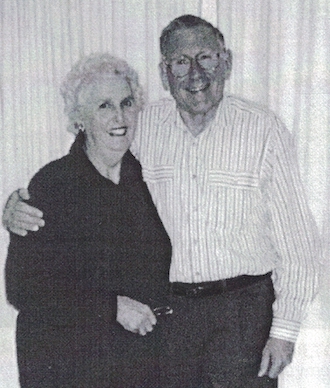
Phillis spent her early years on the family farm at Jibberding where the Congregational Church Hall was used for the school and all social occasions Phillis started school there in 1941. Dorothy Day, the daughter of one of the teachers, lived with the Reudaveys during the week and drove a horse and cart the five miles to the school. When the school closed because of fluctuating numbers, Phillis and her brother Rod were taught by their mother through correspondence
Phillis and John Dolling, Perth 2000
When she was ten, Phillis was sent to live with her maternal grandmother in Maylands, Perth to finish her primary schooling. She then went on to Perth Modern School for five years secondaiy school before training as a Junior Primary schoolteacher. She graduated in 1954. Rod was also sent to school in Perth, living with Norm and Gertrude Robertson but by 1954 he had returned home to work on the farm. Returning home for school holidays Phillis would sew her own ‘ballerina’ dresses and she and Rod would go off with friends to the local dances.
In 1957 Phillis married John Ainsley DOLLING (1935- ) at the North Perth Congregational Church. Phillis had attended this church in the years she lived at Maylands; it was a four-mile bike ride from her grandmother’s house. John was an ANZ bank officer. The couple lived at Derby, WA for two years, where they worshiped at the AIM Aboriginal Mowanjum Mission. On returning to Perth they lived at Floreat Park for twenty-one years, rearing and educating their four children, Christine (1958), Murray (1959), Neil (1962) and Linda (1964).
Phillis and John were both active in the Congregational Church and Youth Fellowship. Phillis was a Parish Councillor for ten years and involved in the Ladies Guild/Fellowship, Bible study groups and family camps. “We enjoyed the fellowship of young Christians so in Floreat Park we continued our Christian journey attending the Methodist Church which in 1977 became the Forum Uniting Church.”
Moving to Albany for three years, Phillis was an Elder at Scots Church, a Guild member and President of the Bible Society Women’s Auxiliary. "In 1982 I was a foundation member for the WA Synod Uniting Church Fellowship Committee and remained on that committee for ten years, then became the Corresponding Member for North West Presbytery as my husband was Pastor of the Port Hedland Uniting Church and Patrol Padre of the East Pilbara Patrol. (1991-1996, Frontier Services)”
In January 1997 the Dollings moved to the Wagin Parish. "Wagin is in the centre of the Great Southern sheep and wheat growing area with many sheep studs in the district and lots of canola. Wagin parish has five preaching places - Dumbleyung, Collanilling, Wagin, Darkan, Duranillin.” Phillis attended two Consultations as a WA delegate. She is the Ecumenical/International Liaison, keeping in touch with Asia/Pacific women's organizations, and was a representative at a Conference in Fiji in 1999. She writes, “I am looking forward to serving God in a new sphere on the Adult Fellowship National committee."
Phillis and John now live in Mandurah south of Perth.
GRAEME JAMES ROBERTSON (1937- )

Only child of James Norman Robertson and Gertrude Murdoch, born on 19 August 1937, at South Perth, WA.
Graeme and Heide Robertson, lnnisfail 2001
Graeme finished school at the age of fourteen and served a five-year apprenticeship as a carpenter and joiner. Three years later he completed his Master Builder Ticket. "I went from there into property development as a natural progression of events." [Letter from Graeme Robertson, 10.12.1998 ] In 1964 he was running tours through the north west of Western Australia and up to Darwin. This venture was successful and in 1967 he formed his own company ‘Walkabout Hotels’, building a hotel at Port Hedland, followed by hotels at Mt Newman, Karratha, Geraldton and Gove in the Northern Territory. He has also been involved in establishing the ‘Monkey Mia Dolphin Resort’ and more recently in the development of the area around Denmark.
Graeme married Heide Elisabeth LENZ (1940- ), at St Aidan’s Church, Claremont, WA on 10 May 1964. Their two sons, Sven (1970) and Peter (1971), are involved in the family business. Graeme’s offices in Claremont are in the old Congregational Church Hall. It was at this church the Robertson family worshipped in earlier times. Graeme bought the property when it was sold after the amalgamation of the Congregational Church into the Uniting Church in 1977.
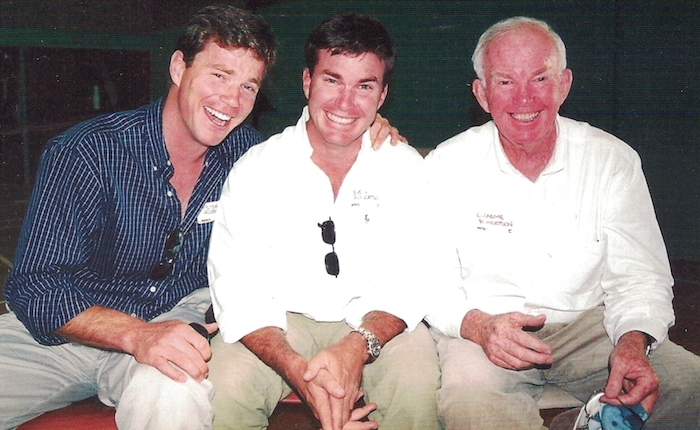
Peter and Sven Robertson with their father Graeme Robertson
Garry Gillard | New: 21 November, 2018 | Now: 18 January, 2024